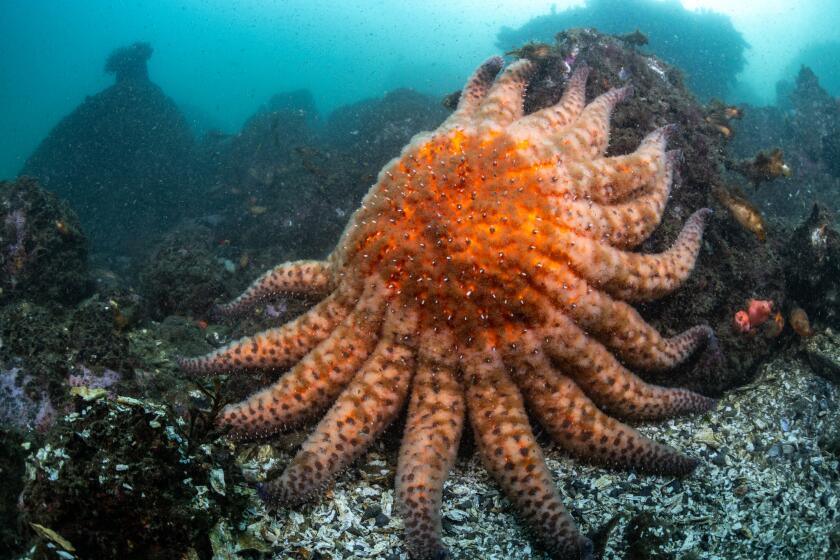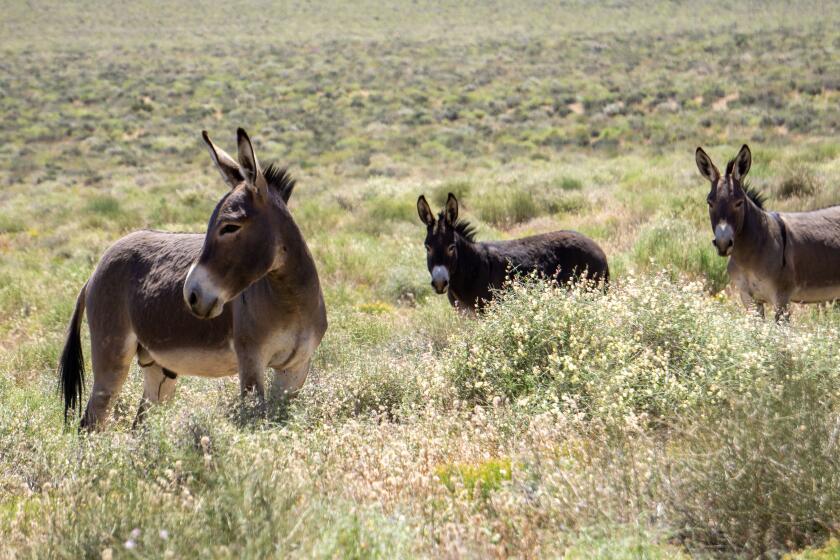A strike from beneath, and a triathlete is gone
- Share via
SOLANA BEACH, CALIF. — The attack was swift and deadly. A shark expert who examined the mangled body said the bite marks showed the classic pattern of a great white: Strike from underneath and then retreat quickly.
Despite attempts by lifeguards at resuscitation, retired veterinarian Dave Martin, 66, a dedicated triathlete who swam every Friday with other fitness buffs, was declared dead just minutes after he was pulled from the water.
A shark estimated at 12 to 17 feet in length had bitten both his thighs, leading to massive bleeding, rescue personnel said. Martin’s death left friends, beach lovers and fellow competitive swimmers in shock.
Though sharks are known to roam the ocean off Southern California, and millions of people swim in the waters annually, this was the first death attributed to a shark attack in San Diego County since 1994.
Officials immediately placed a 72-hour off-limits designation on an eight-mile stretch of the ocean from Torrey Pines to South Carlsbad, prime swimming and surfing territory.
Surfers just as quickly ignored the warnings and got in the water.
Richard Rosenblatt, professor emeritus of marine biology at the Scripps Institute of Oceanography in La Jolla, said the shark probably mistook the wetsuit-clad Martin for a seal.
“This almost certainly was a great white shark,” Rosenblatt said at a news conference near the Solana Beach lifeguard station. “We think it was mistaken identity. A human swimmer is not too unlike a seal.”
Martin was “pushed out of the water in a violent attack, and that’s just typical of great white feeding behavior,” Rosenblatt said. “They normally feed on seals, come up from below, take a powerful bite, then rush away and wait for other animals to come back.”
Martin was swimming with other members of the Triathlon Club of San Diego.
Anita Flagg, 50, who was swimming near him, said she and the others saw “a lot of turbulence in the water” and immediately knew something was terribly wrong.
“I thought someone was having a heart attack or an epileptic seizure,” Flagg said. “Then the girl swimming beside him yelled ‘shark!’ and ‘help!’ and we all swam as fast as we could over there.”
Four other swimmers brought Martin to the beach. “He didn’t look conscious and it looked like his legs were just stumps,” Flagg said. “The lifeguards did CPR, but it was pretty clear they couldn’t save him.”
The group had gone to Solana Beach, about 20 miles north of downtown San Diego, for their 6:30 a.m. swim. The attack occurred about 7 a.m. near Fletcher Cove.
Lifeguards performed cardiopulmonary resuscitation on Martin for nearly 30 minutes. A helicopter was called to take him to a hospital, but he was declared dead on the beach at 7:49 a.m. Three volunteers arrived to provide grief counseling to other swimmers.
The shark had bitten Martin on both legs but his legs were still intact, said Solana Beach Deputy Fire Chief Dismas Abelman. Martin had apparently separated from the rest of his group when he was attacked about 150 yards from shore, he said.
Great white sharks are ambush predators that typically strike from below and behind, according to researchers who study them in the waters around the Farallon Islands near San Francisco. They bite and spit out their prey, returning to feed on the carcass after their victim has weakened or died. It’s considered a self-protective strategy to avoid the sharp teeth and claws of thrashing seals and sea lions, researchers said.
Solana Beach Mayor Joe Kellejian pleaded with residents to stay out of the water Friday. “While we don’t want people to panic, we do want them to listen to the officials,” he said.
Sheriff’s Department and Coast Guard helicopters patrolled the water in search of the shark without success. The Sheriff’s Department helicopter broadcast a message to swimmers and surfers to “leave the water immediately.”
If the shark is located, any decision on trapping or killing it would be left to the National Marine Fisheries Services, a U.S. Fish and Game official said. The great white, whose numbers have dwindled, is a threatened species protected by federal law.
Harbor seals were reportedly seen in the water before the attack, officials said. The presence of seals lounging on the beach at the Children’s Pool area of La Jolla has been one of San Diego’s more enduring and volatile political issues. Sharks feed on seals and sea lions. Animal rights advocates say the seals should be left alone. Other activists say the seals foul the beach, make it unusable for families and may attract sharks to the shallow water.
“I love the seals, but it was clearly a mistake to open a ‘McShark’ in the center of the open-water swimming community of San Diego,” said La Jolla triathlete Mitch Thrower.
“When I swim,” Thrower added, “the seals actually swim very close by in groups. The seal population seems to have increased here in La Jolla and up and down the San Diego coast.”
Other swimmers, including Amanda Benedict, a member of Martin’s swim group, urged the public “not to freak out,” calling the shark attack a “random event.”
Some surfers and bodyboarders hardly needed such urging.
At Cardiff State Beach, just north of Solana Beach, Lynn Austin, 51, a stay-at-home mother from Carlsbad who has been surfing for 40 years, remained in the water despite the warnings of rangers driving along the beach.
Austin, who has a 5-year-old daughter, said her husband thought she was getting her nails done.
Sharks, she said, “usually attack in the morning and evening -- and from what I’ve been told, they spend the rest of the day in deeper water, sleeping. But you don’t want to catch a wave and fall off your board because that’s when you attract sharks, when you do a big splash.”
Justin Sturgeon, 34, of Del Mar was bodyboarding with a couple of others. Of the beach closures, he said: “It’s an advisory. It’s not mandatory. . . . How many times would the same shark attack twice on the same day?”
Martin’s ex-wife, Robin, and other family members and friends converged on the Solana Beach home where the couple had raised four sons and a daughter. Martin was a pilot, loved to visit Mexico and was “a farmer at heart” who grew vegetables, Robin Martin said.
He had begun competing in triathlons about four years ago and was a “big outdoorsman” with a “dry sense of humor, she added.
Martin had formerly been a part-owner of All Creatures Animal Hospital in Del Mar. “He was a very compassionate, nice guy,” said Brenda Zito, who took her cat to Martin for treatment.
In Del Mar, Michael Mulvany, owner of All Creatures, said Martin was “never a high-stress individual. That’s why people enjoyed working with him.”
“He always had a smile on his face, never seemed to get down,” Mulvany said. “That’s what I’ll miss.”
Daniel Rock, manager of B&L; Bike and Sports in Solana Beach, a store specializing in gear for triathletes, said Martin pushed himself hard during training and remained a trim 185 pounds.
“He enjoyed it as a way to keep up his fitness and compete,” Rock said. “He enjoyed the training and the camaraderie. He was a gentleman in a classic sense. A real nice guy.”
Martin had lived in Solana Beach since 1970. Chris Tatum, owner of Do It Yourself Dog Wash, a block from the beach, said Martin often gave free advice on keeping pets healthy.
“He was very young at heart,” Tatum said.
The waters off Southern California are well-known as a white shark nursery, the place were baby whites are born and then hang around catching fish until they grow bigger and stronger. Only after they get much larger do their diets switch to larger prey: marine mammals.
Yet adult great whites rarely venture into Southern California’s near-shore waters, according to the ongoing Tagging of Pacific Predators -- www.topp.org -- at Stanford University’s Hopkins Marine Station in Monterey.
Most of the great white shark attacks off California occur in what has been dubbed “the bloody triangle,” those waters between Monterey Bay, Bodega Bay and the Farallon Islands. The last fatal attack off California was in 2004 in Mendocino County. The victim was a man diving for abalone.
--
gil.reza@latimes.com
molly.hennessy-fiske@latimes.com
--
Times staff writers Tony Perry, Kenneth R. Weiss, William Lobdell and Richard Marosi contributed to this report.
More to Read
Sign up for Essential California
The most important California stories and recommendations in your inbox every morning.
You may occasionally receive promotional content from the Los Angeles Times.











